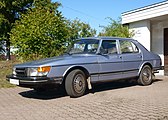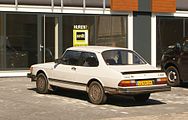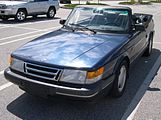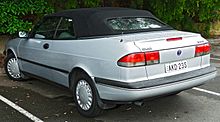Saab 900
| Saab 900 | |
|---|---|
| Production period: | 1978-1998 |
| Class : | Middle class |
| Body versions : | Station wagon , sedan , convertible |
| Previous model: | Saab 99 |
| Successor: | Saab 9-3 |
The Saab 900 is a mid-range model from the Swedish manufacturer Saab , which was produced in two generations from the summer of 1978 to the beginning of 1998.
There were different body styles for both model variants: a three- and five-door station wagon and a two- or four-door sedan with a notchback (called Sedan ). From autumn 1986 it was produced as a convertible based on the two-door sedan.
900 I (1978-1994)
| 1st generation | |
|---|---|
|
Saab 900 (1978-1986) |
|
| Production period: | 1978-1994 |
| Body versions : | Station wagon , sedan , convertible |
| Engines: |
Petrol engines : 2.0–2.1 liters (74–136 kW) |
| Length: | 4680-4880 mm |
| Width: | 1690 mm |
| Height: | 1430 mm |
| Wheelbase : | 2517 mm |
| Empty weight : | 1300 kg |
The first Saab 900 was presented in September 1978 as a further development of the Saab 99 .
The front section and cockpit were changed and the wheelbase was lengthened, but Saab-typical details such as the ignition lock installed between the front seats, self-repairing bumpers (return to their original shape at impact speeds of up to 7 km / h) or the driver's seat heating were retained. The chassis and the two-liter engine with exhaust gas turbocharger were also adopted from the 99. Carburetor and injection engines were also available. The engine was installed at an angle of 45 ° to the right along the front axle and transferred its power to the gearbox below via a roller chain .
At the start of production in the summer of 1978, it was initially only sold as a hatchback sedan with three or five doors. In the spring of 1980 the notchback sedan called sedan was added.
The 1979 and 1980 model years were very different from the later models. Details such as the gear knob, glove compartment lid, seats and covers, exterior mirrors, door and trunk linings, decorative strips, steering wheels, center console, belt locks, bumpers, and ventilation grilles were given a new shape in the fall of 1980 (model year 1981). The large tailgate, which was initially taken over from the 99, had already been redesigned a year earlier; so it received a narrower outside handle and taillights. The rear now had two pairs of taillights.
The most important difference in the engines: The 1979/1980 model years still had the so-called B engine, which however often suffered from defective water pumps and distributor shafts. The H-engine used from model year 1981 was now lighter, the water pump was no longer integrated into the engine block and the ignition distributor was driven directly by the overhead camshaft. The first two years of the 900 are almost impossible to find in Germany and are therefore now coveted collector's items.
In 1981, the Saab 900 was also converted into a station wagon. This variant is known as Safari . However, only two vehicles are known, one of which is on display in the Saab Museum in Sweden. The 74 kW two-liter gasoline engine serves as the drive. The long overhang at the back is a striking detail.
In the summer of 1982, the APC ( automatic performance control ) system was introduced into the turbos . This device, consisting essentially of a knock sensor , control unit and vacuum-operated bypass valve (“waste gate”), adapts the boost pressure to the respective type of gasoline. Now it was also possible to fill up with low-octane gasoline without fear of engine damage. In the B engine, however, the boost pressure was not yet regulated; this engine was only allowed to run on high-octane gasoline.
In the autumn of 1983, an engine with two overhead camshafts and four-valve technology was introduced. This generated a maximum torque of 273 Nm at 3000 rpm. and developed 175 PS (129 kW) (later in the G-Kat version 160 PS (118 kW)). This variant was equipped with charge air cooling from the start; the 8-valve turbos (which continued to be produced in parallel) did not get them until two years later.
Facelift
In the late summer of 1986, the Saab 900 underwent another facelift and received a streamlined front section and wider bumpers. In the same year the 900 Cabrio appeared, initially (albeit in very small numbers) with the old, steep front.
In autumn 1987 the 900 was technically revised again. The handbrake was now on the rear wheels. The bolt circle was changed. An anti-lock braking system was now also available.
With the takeover by General Motors there were first technical interventions in the engines of the 900 I. In addition to the turbo engine with 160 HP (118 kW), the volume model 900 S was created, which without the above-mentioned blow-off valve (APC), without charge air cooling and with a had to get by with a shorter primary ratio (soft turbo). This model variant was cheaper, but with 141 PS (104 kW) only marginally weaker and therefore achieved good sales figures. However, the high technical standard and the pioneering position of the brand in turbo technology were neglected. Since the production costs hardly made the car profitable because of the long assembly times and the complex and expensive components, major savings measures were necessary. Unfortunately, this also led to a loss of quality.
Three years after the takeover by General Motors, the successful but no longer profitable model 900 I was discontinued and replaced by a successor with the same name, which was based on the Opel Vectra and therefore had a transverse engine and a different chassis and was also replaced by a new one Form stood out from its predecessor.
A total of 908,810 copies of the 900 were made. The hatchback rolled off the assembly line until the end of 1993, while the convertible was built until mid-1994. Production of the Sedan ended at the end of 1991.
present
95 vehicles were scrapped in Germany by September 2009 as part of the scrapping bonus .
Datasheet Saab 900
| Saab 900 | GL | GLS | GLi / GLE | turbo | Turbo 16 |
|---|---|---|---|---|---|
| Engine: | 4-cylinder in-line engine (four-stroke) | ||||
| Displacement: | 1985 cc | ||||
| Bore × stroke: | 90 × 78 mm | ||||
| Performance at 1 / min: | 74 kW (100 PS) at 5200 |
79.5 kW (108 hp) at 5200 |
87 kW (118 hp) at 5500 |
106.5 kW (145 hp) at 5000 |
118 kW (160 hp) at 5500 |
| Max. Torque at 1 / min: | 162 Nm at 3500 | 164 Nm at 3300 | 167 Nm at 3700 | 235 Nm at 3000 | 255 Nm at 2800 |
| Compression: | 9.5: 1 | 7.2: 1 | |||
| Mixture preparation: | 1 × Zenith-Stromberg 175 | 1 × double carburetor | Mech. Bosch injection | Bosch K-Jetronic, Garrett turbocharger max. Boost pressure 0.7 bar |
|
| Valve control: | Overhead camshaft, chain drive | ||||
| Cooling: | Water cooling | ||||
| Transmission: | 4- or 5-speed gearbox aW Borg-Warner three-speed automatic front - wheel drive |
||||
| Front suspension: | two unequal length wishbones, coil springs | ||||
| Rear suspension: | Rigid axle, two watt rods lengthways, Panhard rod, coil springs | ||||
| Brakes: | Disc brakes all around, servo | ||||
| Steering: | Rack and pinion steering, partly servo | ||||
| Body: | Sheet steel, self-supporting | ||||
| Track width front / rear: | 1420/1430 mm | ||||
| Wheelbase: | 2515 mm | ||||
| Dimensions: | 4740 × 1690 × 1420 mm | ||||
| Empty weight: | 1150-1220 kg | 1190-1290 kg | |||
| Maximum speed (factory): | 160 km / h | 170 km / h | 175 km / h | 195 km / h | |
| 0-100 km / h (factory): | 14.5 s | n / A | 12.5 s | 8.5 s | |
| Consumption (liters / 100 kilometers, factory): |
11.6 S. | n / A | 12.7 p | 13.8-14.6 S. | |
| Price (February 1982): | 21,900 DM | 23,050-25,200 DM | 25,250–28,750 DM | 31,900-35,150 DM | |
900 II (NG, 1993-1998)
| 2nd generation | |
|---|---|
|
Saab 900 sedan (1993–1998) |
|
| Production period: | 1993-1998 |
| Body versions : | Station wagon , convertible |
| Engines: |
Petrol engines : 2.0–2.5 liters (96–136 kW) |
| Length: | 4637 mm |
| Width: | 1711 mm |
| Height: | 1436 mm |
| Wheelbase : | 2600 mm |
| Empty weight : | 1295-1465 kg |
The second 900 was the first General Motors -directed Saab model when it appeared in the summer of 1993 . When producing many parts from other GM models were used, for example, large parts of the underbody of the Opel Vectra A . Outwardly, the car was similar to the first 900, but the distinctive body edges were now slightly rounded. Technically, the most noticeable change compared to the predecessor was that the engine was now installed transversely, the gearbox was now on the left of the machine. The more compact drive led to improved space in the interior.
In addition to the typical Saab four-cylinder engines (with and without turbocharging ), the engine variants also included a V6 unit from the Opel range , which, however, sold poorly because customers perceived it as untypical for Saab. The buyer could also choose between the equipment variants S and SE. From the summer of 1994, the Saab 900 II was also offered as a convertible.
273,568 copies of the 900 II were made.
The successor model was the Saab 9-3 , which was introduced at the beginning of 1998 and which was provided with a total of 450 new components due to reliability problems of its predecessor.
Engine variants
| model | Cylinders / valves |
Displacement | Maximum power | Max. Torque | Engine code | Construction period |
|---|---|---|---|---|---|---|
| 2.0i | 4/16 | 1985 cc | 98 kW (133 hp) at 6100 min -1 | 180 Nm at 4300 min -1 | B206I | 07 / 1993-07 / 1994 |
| 2.0i | 4/16 | 1985 cc | 96 kW (130 hp) at 6100 min -1 | 177 Nm at 4300 min -1 | B204I | 08 / 1994-02 / 1998 |
| 2.0 turbo | 4/16 | 1985 cc | 136 kW (185 hp) at 5500 min -1 | 263 Nm at 2100 min -1 | B204L | 07 / 1993-02 / 1998 |
| 2.0 turbo | 4/16 | 1985 cc | 136 kW (185 hp) at 5750 min -1 | 230 Nm at 2000 min -1 | B204L | 07 / 1993-02 / 1998 |
| 2.3i | 4/16 | 2290 cc | 110 kW (150 hp) at 5700 min -1 | 210 Nm at 4300 min -1 | B234I | 07 / 1993-02 / 1998 |
| 2.5i V6 | 6/24 | 2498 cc | 125 kW (170 hp) at 5900 min -1 | 227 Nm at 4200 min -1 | B258I | 07 / 1993-02 / 1998 |
- ↑ With manual transmission
- ↑ With automatic transmission
Web links
literature
- Automobil Revue , catalog number 1982 (data)
- Saab 900 owner's manual for model year 1995
Individual evidence
- ↑ saabsafari.com.
- ↑ http://www.forum-auto.de/sites/default/files/page/technik/technik_APC.htm
- ↑ a b Saab Factory - Trollhättan, Sweden on: www.saabhistory.com. Retrieved October 12, 2009.
- ↑ Final report on the environmental bonus. (PDF) Federal Office of Economics and Export Control, accessed on February 13, 2015 .















